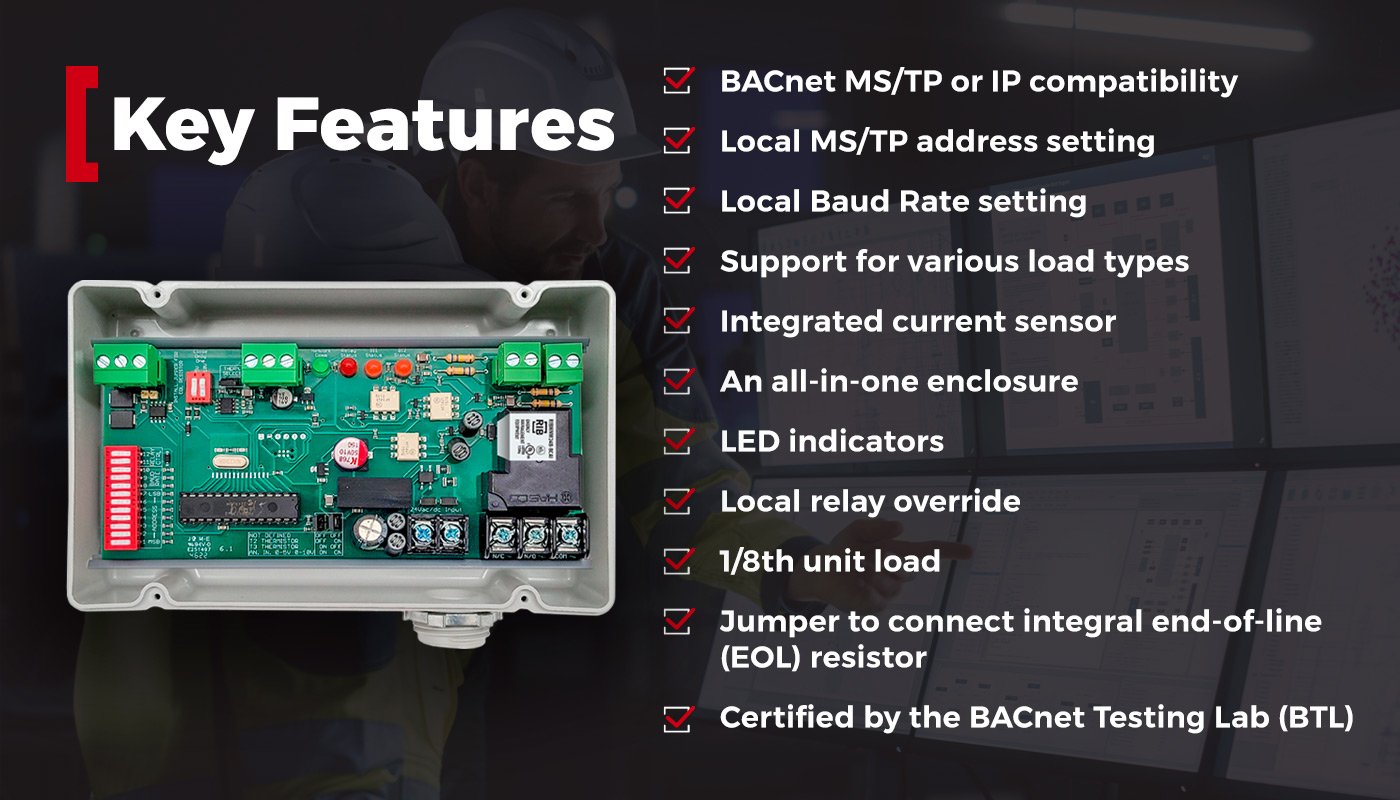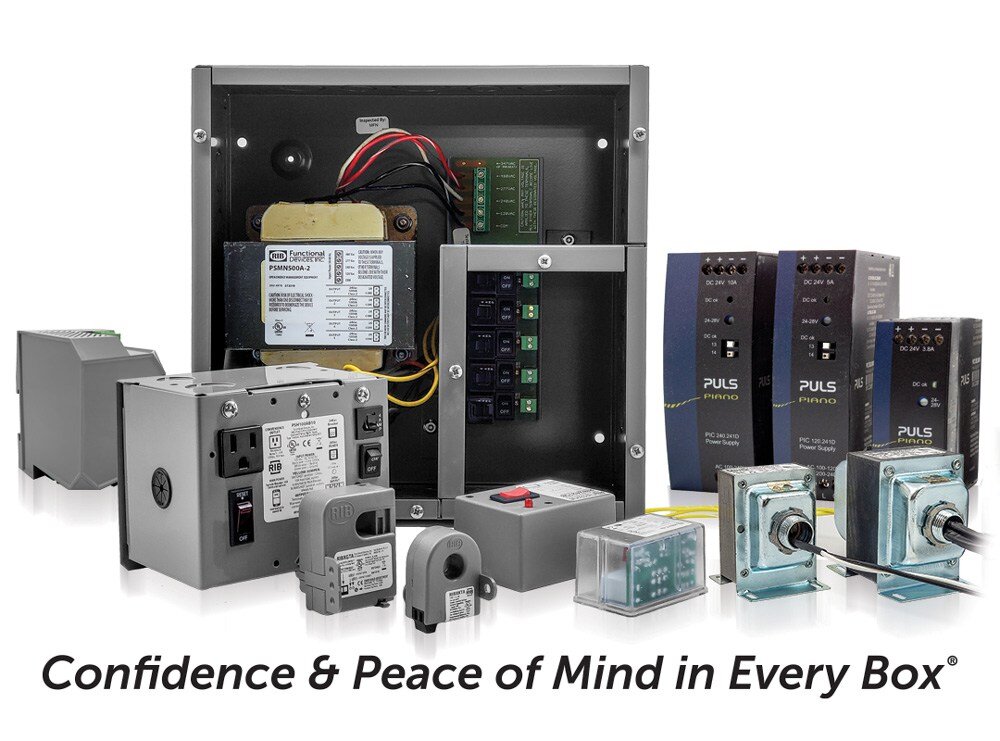
BACnet-compatible products simplify integration, improve system interoperability, and allow facility managers to expand or upgrade their BAS without being locked into a single vendor.
The engineers here at Functional Devices design many of our RIB® (Relay-In-a-Box) relays to be BACnet compatible, making them a versatile choice for networked building automation. These relays provide reliable control of lighting, HVAC, and other loads while offering the ability to communicate status and receive commands directly over a BACnet network.
In this post, we’ll explore the benefits, features, and applications of BACnet-compatible RIB relays, along with answers to frequently asked questions we receive.
Why Use BACnet Compatable RIB Relays?
Building automation controllers can be quite expensive, and purchasing one just to add a couple more points on the network may not be ideal. Luckily, a BACnet-compatible RIB relay offers a good solution.
Here are some advantages of utilizing a BACnet RIB relay over a larger controller:
- Avoids unnecessary costs of a larger controller.
- Provides a practical solution for simple system add-ons (like a single device).
- Allows for simpler installation with preassembled design and flexible mounting options.
- Functions seamlessly within the existing network.
- Promotes enhanced control and real-time monitoring for better efficiency and decision making.
- Adaptable for various applications.
With their potential cost savings, easy installation, and versatility, BACnet-enabled RIB relays are a good choice for many BAS.
Key Features of BACnet RIB Relays
Now let’s dive into features of our BACnet RIB Relays! They can be powered from a range of 24Vac/dc up to 277Vac and use standard BACnet objects: binary input, binary output, analog input, analog output, accumulator, and device. The Protocol Implementation Conformance Statement (PICS), available for download on our website, indicates which objects each model uses.
Beyond multi-voltage operation and configurable inputs and outputs, our BACnet-enabled RIB relays will have one or more of the following specifications:

All our BACnet RIB relays boast easy integration into controllers and supervisory systems, ready to upgrade your BAS without any headache.
Common Applications in Building Automation
You’re probably thinking right now, “Ok, great, but how would I actually use a BACnet RIB relay?” Well, we’re glad you (probably) asked! These intelligent field devices can work in all types of systems including HVAC, lighting controls, equipment control, and more.
Here are some examples:
HVAC
- Safely manage high-voltage equipment such as fans, valves, and pumps.
- Turn on exhaust fans in response to an environmental trigger or schedule.
- Make occupancy-based adjustments to save energy.
- Control a gas detection system for safe boiler shutdown.
Lighting
- Control lighting systems with occupancy sensors and schedules.
- Manage a circuit of multiple lights at once.
- Connect low-voltage controllers or high-voltage systems.
Equipment Control
- Turn on and off a building’s water feature according to a schedule.
- Power up a low-horsepower motor.
- Monitor current draw for real-time analysis and fault detection.
As you can see, your imagination is the limit when it comes to BACnet RIB relay applications.
Frequently Asked Questions About BACnet-Compatible RIB Relays
Since BACnet-enabled RIB relays can be more complex than traditional RIB devices, we often receive technical support questions about setup and operation. To make things easier, we’ve compiled answers to some of the most common questions below.
Q: What happens if I change the Baud Rate or MS/TP Address?
A: After making changes to either setting, you must power cycle the device for the updates to take effect.
Q: When should I use the EOL jumper?
A: Only use the End-of-Line (EOL) jumper if the device is physically located at the end of the communication trunk.
Q: What type of cabling is recommended?
A: We recommend 22–24 AWG shielded, twisted-pair cabling for best performance.
Q: Can I connect 24 Vac to both a RIB relay and a half-wave device?
A: Doing so can cause damage. To prevent this:
- Use separate transformers for each device, or
- Add a diode between the devices.

Q: What is the default Device ID, and can it be changed?
A: The default Device ID is 277XXX, where “XXX” matches the MS/TP address set on the DIP switches. You can change the Device ID by writing to the Object Identifier Property of the Device Object. The exact process varies by controller, so contact our team if you need assistance.
See Why Facility Managers Love BACnet RIB Relays
BACnet-compatible RIB relays are a smart choice for today’s BAS because they provide seamless integration, enhanced control, and valuable monitoring capabilities. By supporting BACnet communication, these relays make it easier to connect devices across a BAS network, reduce installation complexity, and improve system efficiency. The result is greater flexibility, scalability, and reliability for modern facilities.
For help selecting the right RIB relay and ensuring proper implementation in your next project, reach out to Functional Devices. Our team is ready to provide the expertise and support you need to build smarter, more efficient automation systems.
Explore our full line of BACnet-compatible RIB relays today!
About Functional Devices, Inc.

Functional Devices, Inc., located in the United States of America, has been designing and manufacturing quality electronic devices since 1969. Our mission is to enhance lives in buildings and beyond. We do so by designing and manufacturing reliable, high-quality products for the building automation industry. Our suite of product offerings include RIB relays, current sensors, power controls, power supplies, transformers, lighting controls, and more.
We test 100% of our products, which leads to less than 1 out of every 16,000 products experiencing a failure in the field.
Simply put, we provide users of our various products confidence and peace of mind in every box.

